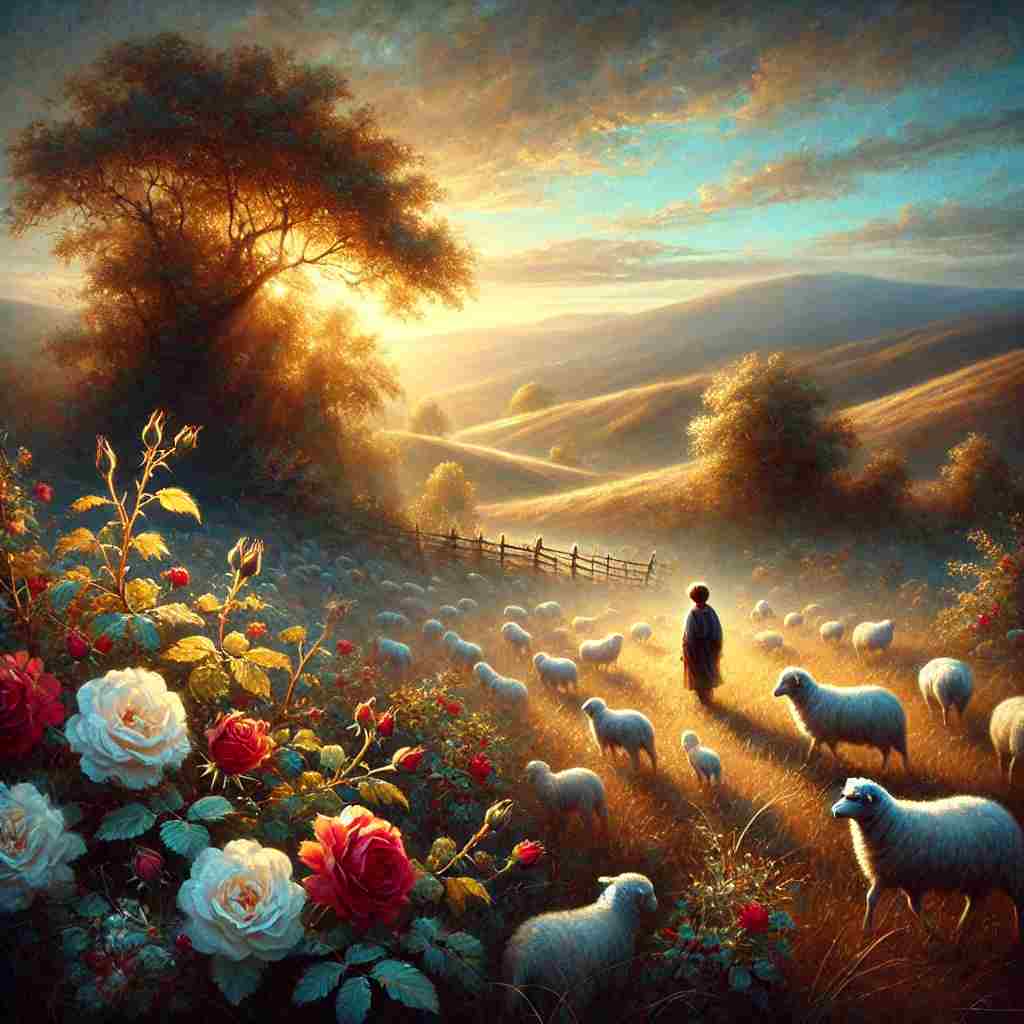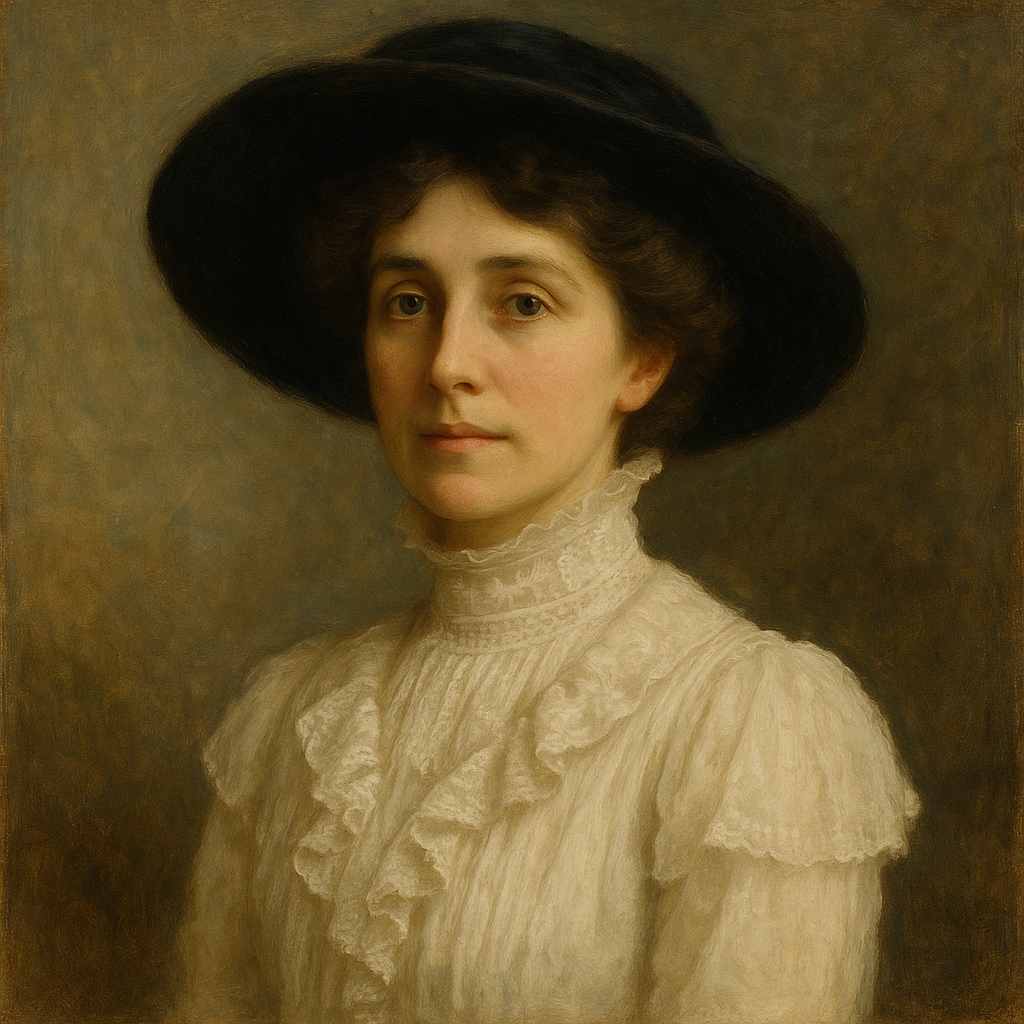The Enchanted Sheep-Fold
Josephine Preston Peabody
1874 to 1922

The hills far-off were blue, blue,
The hills at hand were brown;
And all the herd-bells called to me
As I came by the down.
The briars turned to roses—roses,
Ever we stayed to pull
A white little rose, and a red little rose,
And a lock of silver wool.
Nobody heeded,—none, none;
And when True Love came by,
They thought him nought but the shepherd-boy.
Nobody knew but I!
The trees were feathered like birds, birds;
Birds were in every tree.
Yet nobody heeded, nobody heard,
Nobody knew, save we.
And he is fairer than all,—all.
How could a heart go wrong?
For his eyes I knew, and his knew mine,
Like an old, old song.
Josephine Preston Peabody's The Enchanted Sheep-Fold
In The Enchanted Sheep-Fold by Josephine Preston Peabody, the poet crafts a delicate pastoral scene imbued with themes of love, beauty, and secrecy. The poem’s structure and language evoke a sense of idyllic simplicity, but there are layers of meaning that deepen the text. Through Peabody’s use of repetitive phrasing, vivid natural imagery, and an underlying sense of intimacy, she conveys the joy of a shared secret within a secluded, enchanted world. The poem suggests an almost timeless connection between the speaker and her “True Love,” whom the outside world fails to recognize.
Structure and Form
The poem is divided into five quatrains, each with a loosely consistent rhythm that creates a gentle, lilting tone, fitting for its pastoral setting. The rhyme scheme follows an ABCB pattern, which emphasizes the song-like, folk-ballad quality of the verses. This ballad structure supports the poem’s theme of love and secrecy, suggesting a story passed down or quietly remembered.
Analysis of Imagery and Repetition
Peabody’s use of repetition is notable in the frequent doubling of words like “blue, blue,” “roses—roses,” “birds, birds,” and “all,—all.” This technique emphasizes the enchanting nature of the surroundings, imbuing each element of nature with a magical quality. By doubling these words, the poet intensifies the presence of each feature, making the scene seem both dreamlike and eternal, as if these images were suspended in a timeless space.
-
In the first stanza, the juxtaposition of “blue” and “brown” in “The hills far-off were blue, blue, / The hills at hand were brown” sets up a contrast between distant, perhaps idealized landscapes and the closer, more grounded present. This distinction may mirror the contrast between an idealized love and a present reality.
-
The “briars turned to roses—roses” suggests transformation and magic, as common briars bloom into roses, symbolizing love. This enchanting change indicates that the world itself becomes gentler, more beautiful, and inviting through the presence of True Love.
Themes of Secrecy and Recognition
The poem emphasizes the theme of secrecy, especially through the speaker’s awareness of True Love’s identity, which remains hidden to others. Phrases like “Nobody heeded,—none, none” and “Nobody knew but I” highlight the isolation of the lovers’ experience. Peabody creates a contrast between the mundane and the extraordinary, as the other characters overlook the shepherd boy’s true nature. This oversight by “nobody” enhances the lovers’ connection, as only the speaker sees the shepherd boy as True Love, a recognition that remains invisible to everyone else.
This secret awareness is echoed in the fourth stanza, where nature itself seems to reflect the couple’s love. “The trees were feathered like birds, birds; / Birds were in every tree” implies that the natural world is somehow animated by their connection. In addition, “nobody heeded, nobody heard, / Nobody knew, save we” underscores their unique bond, as if the entire world remains oblivious to this private understanding. It elevates their love to something sacred, hidden, and exclusively theirs.
Symbolism of Love and the “Old, Old Song”
The final stanza presents the culmination of the poem’s themes, where the speaker’s love is seen as transcendent and deeply familiar. When Peabody writes, “And he is fairer than all,—all. / How could a heart go wrong?” she places the beloved beyond comparison, making him an almost otherworldly figure. The line “For his eyes I knew, and his knew mine, / Like an old, old song” suggests a bond that is ancient, timeless, and perhaps fated. The “old, old song” symbolizes an eternal connection, possibly evoking the idea of love as a force that exists across lifetimes, or as a melody that resonates beyond conscious memory.
Conclusion
In The Enchanted Sheep-Fold, Peabody’s combination of pastoral imagery, repetition, and themes of love’s secrecy builds a serene yet profound portrait of romantic love that feels both timeless and deeply personal. The speaker’s ability to recognize True Love in the form of a shepherd-boy, unseen by others, casts their bond as a sacred secret shared between them and the natural world. The poem’s subtle magic lies in its ability to convey a sense of eternal love—a love that feels as natural and essential as the trees, birds, and hills in which it is nestled. Peabody ultimately celebrates a connection so deep that it becomes its own “old, old song,” known only to those who truly understand it.
This text was generated by AI and is for reference only. Learn more
Want to join the discussion? Reopen or create a unique username to comment. No personal details required!



Comments
No comments yet. Be the first to comment!